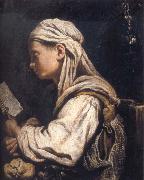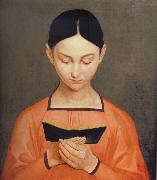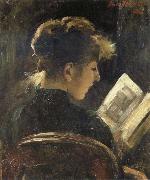Wholesale Oil Painting No Minimum |
|||||||||||
|
|
|||||||||||

|
|||||||||||
|
|
|
||||||||
Domenico FettiItalian painter , Rome 1589 - Venice 1623 was an Italian Baroque painter active mainly in Rome, Mantua and Venice. Born in Rome to a little-known painter, Pietro Fetti, Domenico is said to have apprenticed initially under Ludovico Cigoli, or his pupil Andrea Commodi in Rome from circa 1604-1613. He then worked in Mantua from 1613 to 1622, patronized by the Cardinal, later Duke Ferdinando I Gonzaga. In the Ducal Palace, he painted the Miracle of the Loaves and Fishes. The series of representations of New Testament parables he carried out for his patron's studiolo gave rise to a popular specialty, and he and his studio often repeated his compositions. In August or September 1622, his feuds with some prominent Mantuans led him to move to Venice, which for the first few decades of the seventeenth century had persisted in sponsoring Mannerist styles (epitomized by Palma the Younger and the successors of Tintoretto and Veronese). Into this mix, in the 1620s?C30s, three "foreigners"??Fetti and his younger contemporaries Bernardo Strozzi and Jan Lys??breathed the first influences of Roman Baroque style. They adapted some of the rich coloration of Venice but adapted it to Caravaggio-influenced realism and monumentality. In Venice where he remained despite pleas from the Duke to return to Mantua, Fetti changed his style: his formalised painting style became more painterly and colourful. |
||||||||
|
|
||||||||
Girl Reading
Girl Reading Painting ID:: 41522 |
mk164
c.1620
Gallerie dell-Accademia
Venice
mk164 c.1620 Gallerie dell-Accademia Venice |
|||||||
|
|
||||||||
Gustav Adolph Henning1797-1869 |
||||||||
|
|
||||||||
|
|
Girl Reading
Girl Reading Painting ID:: 41537 |
mk164
1828
Museum der Bildenden Kunste
Leipzig
mk164 1828 Museum der Bildenden Kunste Leipzig |
||||||
|
|
||||||||
Lovis CorinthGerman Painter, 1858-1925 German painter and writer. He grew up on his family's farm and tannery. As a child he showed interest in art, taking informal lessons in drawing from a local carpenter and caricaturing his primary school teachers. Corinth's father sent him to secondary school in the nearby city of K?nigsberg (now Kaliningrad), where he lived with his widowed aunt. A superstitious woman fond of story-telling, she possessed what Corinth later described as a coarse temperament and an unrestrained, 'demonic' humour. These qualities and his aunt's bohemian acquaintances, including fortune-tellers and soothsayers, fascinated the young Corinth, accustomed to his more reserved parents. |
||||||||
|
|
||||||||
|
|
Girl Reading
Girl Reading Painting ID:: 41549 |
mk164
1888
mk164 1888 |
||||||
|
|
||||||||
Georgios JakobidesLesbos 11 January 1853 - Athens 13 December 1932) was a Greek painter and one of the main representatives of the Greek artistic movement of the Munich School. He founded and was the first curator of the National Gallery of Greece in Athens. His first education was in Izmir, Turkey. From 1870 to 1876 Jakobides studied sculpture and painting at the Athens School of Fine Arts, and in 1877 he went to the Akademie der Bildenden Kenste in Munich on a scholarship to continue his painting studies under Karl Theodor von Piloty. In Munich he lived for 17 years where he worked in his studio, painting mythological scenes, genre pictures, and portraits. His work is influenced by German academic Realism, his most famous paintings were of children. In the capital of Bavaria he was regarded as a successful German artist selling many of his works at high prices. The Greek government invited him in 1900 to return to Athens to organize the National Gallery of Athens, and in 1904 he was appointed Director of the Athens School of Fine Arts where he taught for 25 years. At this time, additional to his themes he produced formal portraits of eminent Greeks (e.g.Queen Sophia). He opposed all new artistic tendencies, including Impressionism and Expressionism, but supported younger artists to follow their own individual artistic tendencies. He was given awards at five international exhibhits: among those in Berlin 1891 and in Paris 1900. |
||||||||
|
|
||||||||
|
|
Girl reading
Girl reading Painting ID:: 91615 |
Oil on canvas, 53 x 40 cm.
Date c. 1882(1882)
cyf Oil on canvas, 53 x 40 cm. Date c. 1882(1882) cyf |
||||||
|
|
||||||||
|
Georgios Jakobides Lesbos 11 January 1853 - Athens 13 December 1932) was a Greek painter and one of the main representatives of the Greek artistic movement of the Munich School. He founded and was the first curator of the National Gallery of Greece in Athens. His first education was in Izmir, Turkey. From 1870 to 1876 Jakobides studied sculpture and painting at the Athens School of Fine Arts, and in 1877 he went to the Akademie der Bildenden Kenste in Munich on a scholarship to continue his painting studies under Karl Theodor von Piloty. In Munich he lived for 17 years where he worked in his studio, painting mythological scenes, genre pictures, and portraits. His work is influenced by German academic Realism, his most famous paintings were of children. In the capital of Bavaria he was regarded as a successful German artist selling many of his works at high prices. The Greek government invited him in 1900 to return to Athens to organize the National Gallery of Athens, and in 1904 he was appointed Director of the Athens School of Fine Arts where he taught for 25 years. At this time, additional to his themes he produced formal portraits of eminent Greeks (e.g.Queen Sophia). He opposed all new artistic tendencies, including Impressionism and Expressionism, but supported younger artists to follow their own individual artistic tendencies. He was given awards at five international exhibhits: among those in Berlin 1891 and in Paris 1900. Girl reading Oil on canvas, 53 x 40 cm. Date c. 1882(1882) cyf |
||||||||
|
|
||||||||
|
Prev Next
|
||||||||
|
|
||||||||
|
Related Paintings to Georgios Jakobides :. |
||||||||
|
|
||||||||
|
CONTACT US |




